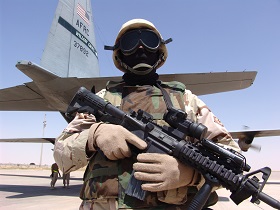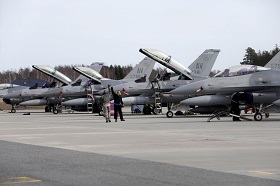On April 22, 2015, RIAC held its first open webinar on the nuclear element in Russian-American relations. To sum up the event, RIAC expert Alexey Fenenko, Leading Researcher at the RAS Institute of International Security Problems, gave an interview sharing his views on the dangers of modern military conflicts and their similarities to the wars of 17th–18th centuries used by the European royal households to divide the continent.
What commonalities can we find between the conflicts in Iraq, former Yugoslavia, Georgia, Afghanistan, and Chechnya?
Let's start with the basics, military studies. Back in the 1820s, German military theorist Karl Clausewitz defined two types of wars, total and limited, which differ in their goals not their death toll or scale of operations. A total war is aimed at annihilating the enemy or making him surrender, with the standard of victory equal to a deal in which the opposite side has to enter into a bad agreement.
This model prevailed since Napoleon to WWII, while the mid-1950s saw the beginning of the prevalence of limited wars. Americans developed the concept of flexible response, i.e. waging war via compact professional contingents rather than large armies. With the territories of great powers untouched, this kind of war is intended to force the enemy into localized concessions. In fact, this kind of war dominated during the late 17th and 18th centuries.
The winners and losers in a limited war are found not in the paradigm of the Great Patriotic War but within the framework of the 17th-18th-century encounters criticized by Clausewitz. There were other kinds of wars, for example over the Austrian succession. After a change of power in Austria, it took King Frederick II of Prussia just three days to capture Silesia, after which he coerced Austria into a compromise by recognizing the new Austrian rule in exchange for Silesia. So, the war boiled down to the overall recognition of Silesia as part of Prussia. This was the 18th-century model, and the Crimea situation was seemingly identical.
The Great Northern War also offers quite an example. Russian Tsar Peter I spent 21 years in battles against Sweden. However, he did not attach Estlandia, Liflandia and Ingermanlandia, but bought them from Sweden as it was losing the war. But Russia was paying it reparations for 20 years. As a result, the war ended in a compromise with more benefits going to the winner.
What do modern wars result in? In the case of Yugoslavia, Slobodan Milosevic was coerced into accepting the peace settlement. Russia recognized the independence of Abkhazia and South Ossetia but spared the Saakashvili regime. There seems to be a repeat show developing in Ukraine, and all these wars closely resemble those of the 18th-century.
Is there a chance of total war in the nuclear age?
You mean returning from limited to total? Hardly to the WWII type, but cases such as the Italian wars or the Thirty Years War in the 16th-17th centuries seem more probable, in which one battle could last five years. George Orwell described wars of attrition between great powers, when the state of war was permanent and the fighting took place in expanses of ocean. This seems quite possible in the nuclear age. The key is not in the weapon but in the politics – in the victory standard taken up by the statesmen.
The Soviet Union rejected the concept of flexible response, giving rise to the limited war model, in which the other superpower is forced to a compromise without fighting.
After the demise of the USSR, limited wars expanded but the victory standard remained intact – a deal. Americans pioneered the “peace enforcement operation”, while Desert Storm, Yugoslavia, and the second Gulf War had more formidable objectives, i.e. disarming the enemy. At the same time, these wars have shown that the strategy is a no go. Then other great powers, primarily Russia and China, ventured to use regional conflicts to pressurize the United States. The five-day war between Russia and Saakashvili regime was just such a case. The real aim was to make the Americans give up the third BMD site. And this feat was followed by the events in Syria, which were used by Russia and China to restrict the U.S. maneuver. As for Ukraine, Moscow’s aim seems to have been to question the 1991 borders.
Since the 18th century wars have been gaining in intensity and bloodletting. Just remember the campaigns of Peter the Great and Frederick the Great, or the series of encounters over the Spanish, Austrian and Polish succession. The Seven Years War proved the limited war strategy was a dead-end. We now seem to be en route to a major conflict. This philosophy is driving the United States toward a collision with Russia and China over changing the world order, but the nuclear impasse prompts an encounter in neutral territory. Both the five-day war and the Ukraine conflict were rehearsals.
When might such a war occur?
In 20-30 years, since the 21st century is definitely advancing along the lines of the 18th. We can expect a major military conflict in the 2050s, because the limited war strategy appears to lack prospects, and mankind will go on to revive total warfare.
Limited wars have a different victory standard. Regrettably, we are still focused on winning within the paradigm of the Great Patriotic War — defeat and unconditional surrender. But who is the victor in Ukraine? Upon consideration, war should end in compromise. Both sides have declared great goals. The West wants to incorporate Ukraine into the EU association scheme and equip it with a nationalist regime, while Russia seemed ready to follow the Crimea’s addition to Russia with providing assistance to Novorossiya. Finally, Crimea was factored out, and Novorossiya boiled down to the status of Mariupol and Debaltsevo — not Novorossiya from Kharkov to Odessa but just Mariupol and Debaltsevo.
In the 18th century, French Marshall Richelieu described the situation as follows: speaking of a captured Dutch fortress, we mean defeating Holland. In other words, the war’s objective is capturing a border city and dictating one's terms to the opposite party. Modern wars are reproducing the Richelieu model. Since the early 21st century, we see an increasing number of intensive conflicts that are leading to a major collision.
Could such a conflict be avoided?
It seems so far unlikely as the overall trend is developing along the 18th-century paradigm.
And what should Russia prepare for?
We are moving toward a limited conflict with NATO in the territory of a third country, most probably in the Baltic.
Why the Baltic?
First, Americans insist that Russia enjoys a privileged position in the Black Sea, where it once had just a strip from Anapa to Novorossiysk. By attaching Crimea and the treaty with Abkhazia, Russia is effectively controlling the Black Sea waters, where the U.S. is unable to exact revenge. The Baltic seems more appropriate. This is not just my theory, the idea was first voiced by George Friedman and then by Joseph Biden in his Budapest address on May 20, 2014. Russia’s position in the Baltic is much more vulnerable. Kaliningrad is an enclave that can be cut off in the Gulf of Finland to create a casus belli. Russian speakers in the Baltic will also be threatened. You may see NATO infrastructure being deployed. It is not dangerous for Russia but does threaten the Baltic Russians who may face mass persecutions.
The situation seems even worse with Finland and Sweden, where anti-Russian hysteria is mounting. On the eve of the 2014 NATO summit in Wales, preparations had been made for them to enter into military agreements with the alliance. Should this happen, Russia will be cut off from the Gulf of Finland, with the supply line between Kaliningrad and the mainland possibly severed. Finland’s neutrality is of critical importance for Russia. If the country joins NATO, Russia will have to defend Karelia and radically change its national defense policy. The complex of contradictions emerging in the Baltic is genuinely dangerous, as it may detonate and trigger a limited military conflict of larger dimensions.
Do you agree that Sweden and Finland are a special case?
Finland was invariably friendly with the USSR, while Sweden remained neutral. Now Sweden seems eager to revise its detachment. American forward thinking has one more aspect. The United States and Great Britain are far from the Baltic and would not provide the Baltic states any emergency assistance, while Sweden boasts a decent defense potential and may help the Baltic countries out if they get into trouble. Russia should perceive Stockholm’s movement toward NATO as something objectionable. There is nothing dangerous within the 1941 paradigm of total war, while the categories of 1741 suggest that the consequences are quite frightening.
Another potential flashpoint is the Arctic. There is no genuine controversy between countries there, but the region is a key site for power play that could generate cause for an appalling military collision. Just imagine a scenario in which Russia applies for its Arctic sector but is again rejected. What next? Russia is likely to establish its sovereignty unilaterally, and the response of others is far from clear. States are moving toward more intensive conflicts with the local use of nuclear weapons, but the victorious deal will remain the standard outcome.
To this end, what about Asia-Pacific?
Because of the unsettled territorial dispute, Japan is Russia’s biggest regional problem. With the Japanese economy waning, militarized forces are on the rise. Since the 1960s, the country had two camps, with one suggesting the revision of the country’s security treaty with the U.S. to restore Japan’s military sovereignty, the second insisting on initiating conflict and demonstratively losing in the collision in order to achieve a future reconstruction of full-fledged national forces. This paradigm raises Tokyo’s openness to local conflict around the Kuril Islands, which should mean a major security challenge for Russia. The scenario under which a peaceful Japanese landing on the islands and the Diet adopting a resolution on restored sovereignty seems of particular interest. How would Russia respond? By attacking civilians? And why is Russia buying Mistral ships? For a possible collision against Japan or the United States would seem likely.
Interviewer: Maria Gurova, RIAC Website Editor







